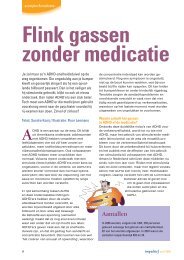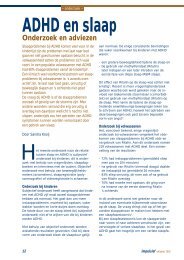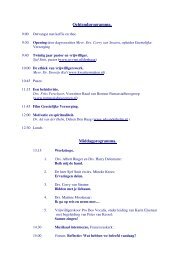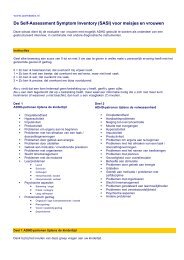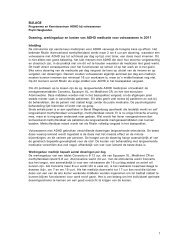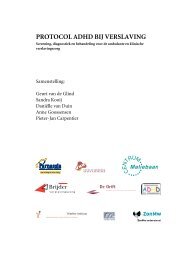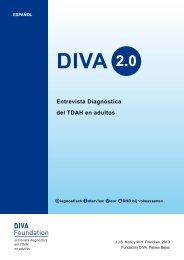Diagnostic Interview for ADHD in adults (DIVA) - PsyQ
Diagnostic Interview for ADHD in adults (DIVA) - PsyQ
Diagnostic Interview for ADHD in adults (DIVA) - PsyQ
You also want an ePaper? Increase the reach of your titles
YUMPU automatically turns print PDFs into web optimized ePapers that Google loves.
Score <strong>for</strong>m<br />
DSM-IV<br />
criterion A<br />
DSM-IV<br />
criterion B<br />
DSM-IV<br />
criterion C<br />
and D<br />
DSM-IV<br />
criterion E<br />
Childhood<br />
Is the number of A characteristics ≥ 6?<br />
Is the number of H/I characteristics ≥ 6?<br />
Adulthood*<br />
Is the number of A characteristics ≥ 6?<br />
Is the number of H/I characteristics ≥ 6?<br />
Are there signs of a lifelong pattern of symptoms and limitations?<br />
The symptoms and the impairment are expressed <strong>in</strong> at least<br />
two doma<strong>in</strong>s of function<strong>in</strong>g<br />
Adulthood<br />
Childhood<br />
The symptoms cannot be (better) expla<strong>in</strong>ed by the presence<br />
of another psychiatric disorder<br />
Is the diagnosis supported by collateral <strong>in</strong><strong>for</strong>mation?<br />
Parent(s)/brother/sister/other, i.e. **<br />
Partner/good friend/other, i.e. **<br />
School reports<br />
0 = none/little support<br />
1 = some support<br />
2 = clear support<br />
* Research has <strong>in</strong>dicated that at adult age, four or more characteristics of attention problems and/or hyperactivity-impulsivity are sufficient <strong>for</strong><br />
the diagnosis of <strong>ADHD</strong> to be made. Kooij e.a., Internal and external validity of Attention-Deficit Hyperactivity Disorder <strong>in</strong> a population-based<br />
sample of <strong>adults</strong>. Psychological Medic<strong>in</strong>e 2005; 35(6):817-827. Barkley RA: Age dependent decl<strong>in</strong>e <strong>in</strong> <strong>ADHD</strong>: True recovery or statistical<br />
illusion? The <strong>ADHD</strong> Report 1997; 5:1-5.<br />
** Indicate from whom the collateral <strong>in</strong><strong>for</strong>mation was taken.<br />
*** If the established sub-types differ <strong>in</strong> childhood and adulthood, the current adult sub-type prevails <strong>for</strong> the diagnosis.<br />
<strong>DIVA</strong> 2.0 <strong>Diagnostic</strong> <strong>Interview</strong> <strong>for</strong> <strong>ADHD</strong> <strong>in</strong> <strong>adults</strong><br />
❑ Yes / ❑ No<br />
❑ Yes / ❑ No<br />
❑ Yes / ❑ No<br />
❑ Yes / ❑ No<br />
❑ Yes / ❑ No<br />
❑ Yes / ❑ No<br />
❑ Yes / ❑ No<br />
❑ No<br />
Yes, by<br />
Diagnosis <strong>ADHD</strong>*** ❑ No<br />
❑ N/A ❑ 0 ❑ 1 ❑ 2<br />
❑ N/A ❑ 0 ❑ 1 ❑ 2<br />
❑ N/A ❑ 0 ❑ 1 ❑ 2<br />
Explanation:<br />
Yes, subtype<br />
❑ 314.01 Comb<strong>in</strong>ed type<br />
❑ 314.00 Predom<strong>in</strong>antly <strong>in</strong>attentive<br />
type<br />
❑ 314.01 Predom<strong>in</strong>antly<br />
hyperactive-impulsive type<br />
19



